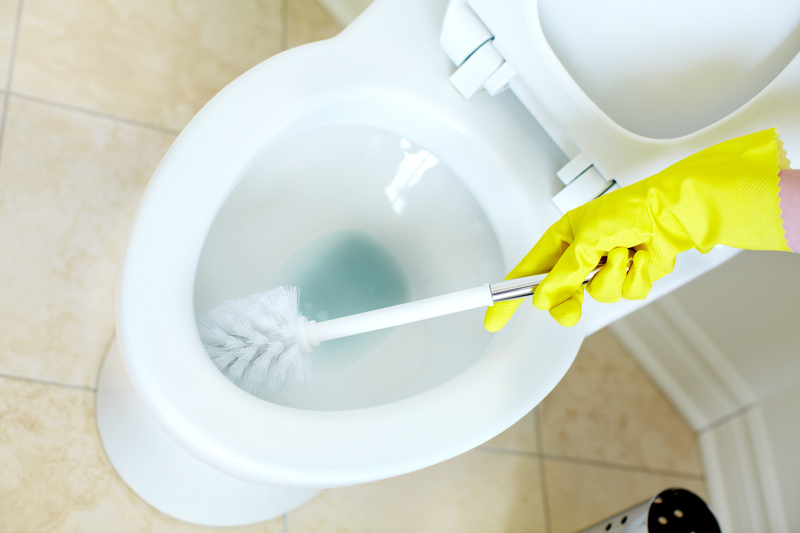The Essential Guide to Sparkling Windows
Posted on 06/09/2025
The Essential Guide to Sparkling Windows
Are your windowpanes often murky, streaked, or covered in grime? Achieving sparkling windows isn't just about boosting curb appeal; it's a gateway to brighter, healthier, and more inviting living and workspaces. In this comprehensive guide, you'll discover expert tips, top techniques, and insider secrets for keeping your windows crystal clear all year long. Whether you're dealing with urban soot, hard water stains, or simply seeking a better view, this is your one-stop resource for pristine, gleaming glass.

Why Clean Windows Matter
Clean, shimmering windows may seem purely aesthetic, but the benefits go far beyond appearance:
- Enhanced natural light: Dirt and residue block sunlight, making interiors look dim and dreary.
- Improved mood & health: Exposure to daylight is scientifically proven to boost mood and well-being.
- Better window longevity: Routine cleaning prevents corrosive substances and hard water from damaging glass and frames.
- Elevated property appeal: Whether selling, renting, or simply enjoying your space, gleaming glass makes everything feel fresher and more cared for.
Understanding Different Window Types
*Not all windows are created equal!* Before starting your window cleaning mission, it's crucial to identify the types of windows in your home or building. The methods and materials you use may vary based on these factors.
- Single-hung/double-hung: Feature one or two movable sashes; common in residential settings.
- Casement: Hinged on the side and opening outward; need to be cleaned from both interior and exterior for a full shine.
- Picture windows: Large, fixed glass panes widely used for maximizing views.
- Sliding windows: Move horizontally, often requiring special care in track cleaning.
- Bay & bow windows: Multi-panel configurations that project outwards, offering panoramic views and additional surfaces.
Each of these requires specific attention for that brilliant, streak-free finish.
Essential Window Cleaning Supplies
Stocking the right tools is the first step toward gleaming glass. Here's what professionals recommend for achieving crystal-clear cleanliness:
- Quality squeegee: The cornerstone of streak-free windows. Invest in a sturdy model with a rubber blade.
- Microfiber cloths: Lint-free and highly absorbent, perfect for buffing glass to a shine.
- Bucket: For your cleaning solution and rinsing tools.
- Soft scrub brush or sponge: For breaking up stubborn grime, dust, or insect residue.
- Non-abrasive cleaner: Either a commercial glass cleaner or a homemade solution (see below).
- Extension pole: Vital for cleaning high or hard-to-reach panes safely.
- Vacuum or brush: For cleaning window tracks and sills.
Tip: Avoid using paper towels or newspapers. While once popular, these can leave lint or ink smears.
The Best Window Cleaning Solutions
Homemade Glass Cleaners
Creating your own window cleaning solution can be cost-effective and eco-friendly. Try these popular recipes:
- Vinegar & Water: Mix 1 part distilled vinegar with 2 parts warm water. Great for dissolving mineral deposits and cutting through grime.
- Lemon Juice Solution: Combine 1 tablespoon lemon juice with 1 quart water for natural, sweet-smelling window cleaning power.
- Dish Soap Mix: Add a few drops of mild dish soap to a bucket of water for breaking up greasy film on glass.
*For extra sparkle,* finish with a final wipe using pure water to remove any residue.
Commercial Glass Cleaners
For fast, effective results--especially on tough jobs--consider specialty glass cleaners formulated to dry quickly and minimize streaks. Choose ammonia-free options when possible to avoid damage to window frames or seals.
Step-by-Step Guide: How to Get Sparkling Windows
Ready to tackle window washing with confidence? Follow this comprehensive, step-by-step approach for deposit-free, glistening glass:
- 1. Clear your workspace: Move window coverings, furniture, or decor out of the way to access the entire window area.
- 2. Dust frames and sills: Use a brush or vacuum attachment to remove loose dirt, cobwebs, or pollen before applying any liquids.
- 3. Wash window screens (if present): Take screens outside and gently scrub with soapy water, then rinse thoroughly and air dry.
- 4. Apply cleaning solution: Generously spray or sponge your glass cleaner (homemade or commercial) onto the pane.
- 5. Agitate and loosen film: Use a soft sponge or scrubber to break up dirt, grime, or bird droppings.
- 6. Squeegee action: Starting at the top left corner, pull the squeegee in a smooth, straight line down the window. Wipe the blade after each pass to avoid streaks.
- 7. Final buff: Use a dry microfiber cloth to wipe away droplets around edges and corners.
- 8. Touch-ups: Inspect the window in natural light for residual smears and polish as needed.
Pro Tip: Wash windows on a cloudy day or during cooler hours. Direct sunlight can cause your cleaning solution to dry too quickly, resulting in streaks.
Common Window Cleaning Mistakes (And How to Avoid Them)
Even seasoned DIYers can slip up. Here are some frequent window washing blunders and quick fixes to keep your windows sparkling:
- Using hard water: Tap water can leave mineral spots; always use distilled or filtered water for a flawless finish.
- Neglecting to clean screens: Dirty screens re-deposit dust and residue as soon as it rains.
- Applying too much product: Excess cleaner causes streaks; less is often more.
- Scrubbing with rough tools: Abrasive pads can scratch glass; only use soft sponges or cloths.
- Ignoring window tracks: Build-up in tracks attracts pests and can impede window function.
Special Challenges: Hard Water Stains & Mineral Buildup
Is your glass marred by cloudy streaks or chalky deposits? Hard water stains and mineral buildup are common, especially near sprinklers or in areas with high mineral content. To treat:
- Apply undiluted white vinegar to the affected area and let sit for 5-10 minutes.
- Scrub gently with a non-abrasive pad.
- Rinse thoroughly and squeegee dry.
- Repeat as necessary for stubborn deposits.
Safety Tips for Window Cleaning
- Never lean out far from windows or over balconies to reach exterior glass. Use a sturdy ladder or extension pole for higher panes.
- Wear gloves to protect your hands (especially when using vinegar or other acidic cleaners).
- Ensure proper ventilation when using chemical cleaners indoors.
- Do not attempt to dismantle windows beyond manufacturer recommendations.
How Often Should You Clean Your Windows?
A regular schedule keeps your windows sparkling and glass in great condition. As a guide:
- Residential homes: Exterior windows every 3-6 months; interior windows every 2-4 months.
- High-traffic commercial properties: Monthly or as needed, especially for glass doors and entryways.
- Homes near busy roads or construction: More frequent cleaning is needed due to dust and pollution.
Note: Spring and autumn are typically ideal seasons for deep cleaning, removing winter grime or pollen buildup.
Eco-Friendly Window Shine: Green Cleaning Options
Care about the planet as well as your view? Eco-friendly window cleaning is easy and cost-effective:
- Use reusable microfiber cloths to cut down on waste.
- Choose plant-based, non-toxic cleaners or simply water and vinegar.
- Recycle or repurpose old newspapers as window-cleaning rags (beware of ink transfer, though).
Professional vs. DIY Window Cleaning
*When is it time to call the pros?* While DIY methods are perfect for most homes, consider hiring professional window cleaners if:
- You have multi-story buildings or inaccessible upper-story windows.
- Glass is heavily stained, scratched, or needs specialized treatment.
- You lack the time, equipment, or desire to do it yourself.
Seasonal Tips for Sparkling Results
Winter Windows
- Avoid cleaning in freezing temperatures--water may freeze on contact with glass.
- Use a splash of rubbing alcohol in your cleaning solution to keep it from freezing.
Summer & Pollen Season
- Rinse windows with plain water before cleaning to remove loose pollen and prevent smearing.
- Clean windows early in the morning or late in the afternoon, avoiding direct sun.
During Heavy Rain
- Post-heavy rains, rinse and spot-clean to minimize mineral or mud spots left by water runoff.
Maintaining Sparkling Windows: Tips for Longevity
To keep your windows looking immaculate in between deep cleans:
- Wipe interior glass every few weeks with a dry microfiber cloth.
- Address fingerprints, dog nose prints, or splashes as soon as you notice them.
- Keep window screens and sills clean; dust and pollen quickly migrate onto glass.
- Check for seal damage or leaks; moisture can cause condensation and fogging.

Frequently Asked Questions About Sparkling Windows
-
What's the best way to clean windows without streaks?
Use a squeegee, work in sections, and dry edges with a microfiber cloth. Avoid cleaning in direct sunlight. -
Can I use vinegar on all types of windows?
Yes, but avoid using vinegar on window frames made of aluminum or stone, as this can cause damage. -
Should I remove screens to clean windows?
If possible, yes. Clean screens separately to eliminate dust and extend the timeframe between washings. -
Is it safe to pressure wash windows?
Use low-pressure settings, and never spray directly at window seals. Too much pressure may break the glass or damage frames.
Conclusion: Enjoy Your Sparkling View
Achieving spotless, sparkling windows is easier than ever with a few simple tools, the right cleaning techniques, and a bit of care. Enhanced light, improved home beauty, and a more cheerful environment await you. Whether you opt for DIY window cleaning or invest in professional help, a clear, unblemished view is always worth the effort.
Ready for your home or business to dazzle? Start applying these tips today and discover the extraordinary difference that genuinely glistening glass can make in your space!



